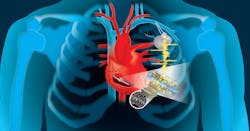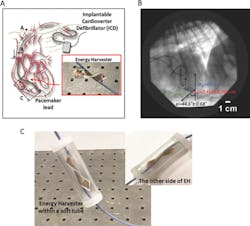The Power of the Heartbeat to Charge Medical Devices
Medical heart devices like pacemakers and defibrillators rely on batteries for power, but these batteries have to be replaced every 5 to 10 years. Every surgery, even ones that are routine like battery replacement, can introduce new complications and can be costly. To help prevent these types of surgeries, researchers at Dartmouth College are developing new methods to generate electricity by leveraging the strength of the human heartbeat.
Engineers at the Thayer School of Engineering at Dartmouth have designed a dime-sized piezoelectric cantilever that is both flexible and porous. The new design incorporates a polyvinylidene fluoride-trifluoroethylene thin film within a dual-cantilever structure wrapped around a pacemaker lead with two free ends. The free ends extend out from the pacemaker to harvest energy from the heart’s motion.
“We’re trying to solve the ultimate problem for any implantable biomedical device,” says Dartmouth engineering professor John X.J. Zhang, a lead researcher on the study which was conducted with help from clinicians at UT Health San Antonio. “How do you create an effective energy source, so the device will do its job during the entire life span of the patient, without the need for surgery to replace the battery?” Along with creating a power source that would last for the duration of the patient'\’s life, the device needs to not interfere with the body’s normal function.
a.) Concept of piezoelectric thin film energy harvester for implantable cardioverter defibrillator and a flexible porous PVDF‐TrFE dual‐cantilever energy harvester on the AICD lead. b.) Video analysis of chronically implanted pacemaker leads from a dog. c.) A dual‐cantilever energy harvester within a soft tube on the AICD lead. (Image credit: Dartmouth College)
“We knew it had to be biocompatible, lightweight, flexible, and low profile, so it not only fits into the current pacemaker structure but is also scalable for future multi-functionality,” adds Dartmouth research associate Lin Dong, first author on the paper.
The research paper “Energy Harvesting: Flexible Porous Piezoelectric Cantilever on a Pacemaker Lead for Compact Energy Harvesting” was published last month and detailed the first three years of research on the project including animal testing results. The initial test results demonstrated a maximum electrical output yield of 0.5 V and 43 nA under the frequency of 1 Hz. The team found that adding a proof mass of 31.6 mg on the dual‐cantilever tip results in a 1.82 times power enhancement.
The research team is currently working under a National Institute of Health funding grant and has two years left to finish the pre-clinical process and obtain regulatory approval. Engineers on the program have also started to investigate how the technology can be used to charge other implanted devices as well.


